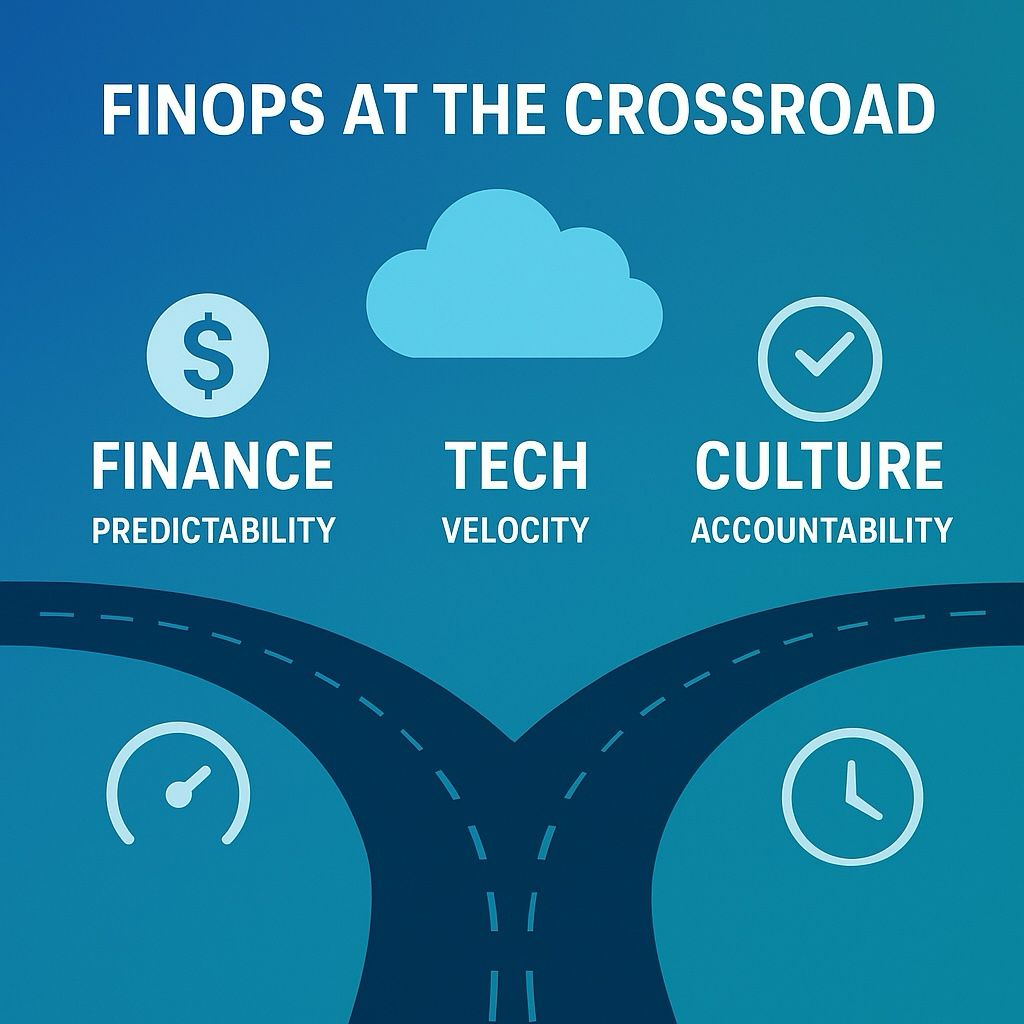If the first wave of cloud adoption was about speed and innovation, the next wave is about control, accountability, and culture. That’s where FinOps comes alive not as a finance function, not as an engineering task, but as a collaboration model.
FinOps is fundamentally a team sport.
The most impactful organisations aren’t the ones with the fanciest automation they’re the ones where finance, engineering, and business leaders speak the same language when it comes to value, cost, and outcomes.
The FinOps Crossroad: When Finance Meets Tech
Traditionally:
Engineering optimises for velocity: deploy fast, scale fast.
Finance optimises for predictability: budget accuracy, cost control.
Cloud changed the rules:
Infrastructure went from a CapEx approval cycle to a real-time OpEx stream with thousands of micro-decisions driving spend every day.
FinOps brings both sides together:
| Finance Mindset | Engineering Mindset | FinOps Harmony |
| Forecast accuracy | Innovation & automation | Cost per outcome |
| Budget governance | Speed to market | Shared accountability |
| Cost visibility | Operational reliability | Transparent trade-offs |
Real-World Collaboration Scenarios (Where FinOps Actually Comes Alive)
FinOps isn’t a theory it plays out in daily conversations between finance and engineering teams. And those conversations can get… interesting. Let’s explore three common scenarios where the FinOps mindset completely changes outcomes.
Reserved Instances & Savings Plans: The Commitment Dilemma
This one is classic:
Finance walks in saying,
“We’re wasting money let’s commit and lock in lower rates.”
Engineering replies,
“We can’t we’re still evolving the architecture!”
Both sides are right. Finance is optimised for predictability. Engineering is optimised for flexibility.
FinOps bridges the gap by using data, not opinions:
- Identify which workloads are truly stable
- Commit only to the predictable baseline
- Leave the fast-moving, experimental workloads free
Suddenly, decisions feel safe. Savings go up. Tension goes down.
The Over-Provisioning Habit: Bigger Isn’t Always Better
Here’s another everyday conflict…
A 32-core VM that barely hits 12% CPU usage.
Finance sees a red flag:
“We’re paying a premium for power we’re not using.”
Engineering pushes back:
“We sized it for peak traffic; downtime is not an option.”
Valid. But oversized resources are silent budget killers.
FinOps helps by creating a risk-free testing environment:
- Performance analytics before any changes
- Safe windows to experiment
- Guardrails and instant rollbacks if needed
The result?
- Cost drops significantly
- Customer experience remains intact
Engineers stay confident. Finance stays happy. That’s what alignment looks like.
The Zombie Graveyard: Idle Resources That Refuse to Die
Snapshots. Old test databases. Forgotten dev clusters.
No one sees them, except the invoice. Finance panics about creeping costs. Engineering shrugs “It’s probably a backup.”
FinOps introduces hygiene with automation:
- Alerts when resources sit idle
- Automatic cleanup after retention deadlines
- Smart storage-tiering so backups cost less
Tiny fixes, massive savings. It’s like housekeeping you don’t notice the mess until someone finally cleans it.
The Human Side: FinOps Is 80% Culture, 20% Tools
Spreadsheets don’t change behaviour. People do.
Most cost issues come from culture:
- “Cloud cost isn’t my responsibility”
- “We deploy and forget”
- “Finance will deal with it later”
- “If no one complains, it’s fine”
FinOps flips that mindset:
- Teams own what they spend
- Finance becomes a partner, not an auditor
- Leadership rewards business value, not just speed
Because here’s the truth:
You can’t optimize what you don’t care about. And you don’t care about what you don’t own.
When teams finally feel accountable, cost optimization becomes continuous and natural.
| Lesson | What It Means in FinOps |
| Early stakeholder alignment | Make cost goals part of product KPIs |
| Clear communication | Replace suspense with dashboards |
| Frequent wins | Start with low-hanging fruit → show success |
| Empathy for engineering | Balance cost with safety & uptime |
| Reward the right behaviours | Celebrate savings as business value delivered |
People adopt FinOps not through pressure — but through proof.
The Future: Culture as the Ultimate FinOps Tool
Automation and dashboards can take you far, but accountability, shared goals, and trust?
That’s where FinOps maturity kicks in.
Companies that succeed in FinOps:
- Leaders embrace cost as a strategic lever
- Teams own both performance and spend
- Everyone knows the business impact of every cloud decision
FinOps isn’t a framework you install. It’s a culture you nurture.
FinOps is where finance, technology, and culture converge and it’s changing how modern organisations think about cloud. It’s no longer enough to move fast in the cloud; the real advantage comes from moving smart. When teams speak the same language, when cost becomes a shared responsibility, and when every cloud decision ties back to value that’s when FinOps truly delivers.
The tools will evolve. The automation will get smarter. But collaboration, accountability, and culture will always be the heart of FinOps. Start small, align your teams, and build momentum because the future of cloud success isn’t just financial or technical, it’s human.
#FinOps #CloudFinance #DigitalTransformation #CloudOptimisation #ProjectManagement #CostManagement #DevOps #ProductManagement #ESG #CloudStrategy #BusinessValue



